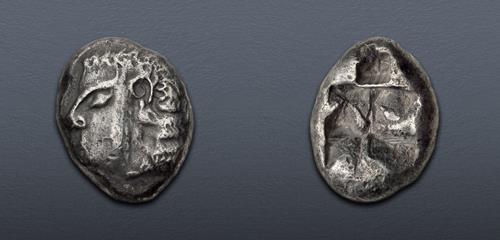|
CARIA or LYCIA, Uncertain. Circa 525/0 BC. AR Stater (17mm, 10.75 g). Aeginetic standard. Archaic head of female left / Two incuse squares of unequal size. J.-A. Chevillon & R. Fournials, “Asie Mineure de Sud-Ouest: un statère inédit à la tortue avec un double carré creux” in NK 30 (2012), fig. 5 (Lycia) = K.A. Sheedy, “The Dolphins, The Crab, The Sphinx and ‘Aphrodite’” in Studies Price, 8 (Caria or Lycia) = ACGC 90 (Uncertain Caria) = BMC Caria, Knidos 1 (Knidos in Caria). Toned, some granularity. VF. The second known of this stater type, the other in the British Museum.
This intriguing archaic stater has traditionally been viewed as part of a group of early silver issues struck with similar incuses, featuring two squares of significantly different size. The majority of these issues were struck on the Aeginetan standard, which Kraay (in ACGC) thought had been adopted through trade between Aegina and communities along the Carian coast and nearby islands. It was believed that the Aeginetan traders introduced silver coinage to this region, which supports the suggestion that these issues were among the first silver coins produced there. While the present issue is undoubtedly linked to the others with this unusual incuse type, the 9.92 gram weight of the only specimen that had been known until recently, the BM piece, was significantly lower than those of the other coins, all of which were between 11.97 and 12.50 grams. While some authors suggested the lower weight was the result of wear, others suggested the coin may have been struck on a different standard, such as the Heavy Lycian standard (9.70-9.90 grams) or the Persian standard (where a double siglos would equal 10.70 grams). These alternative standards, combined with the knowledge that the early Lycian types often were derivative of imported coinage, suggests that this issue may have been among the earliest issues in Lycia. Recently, three other coins from this female head issue came to light; the present stater, a hemistater (Nomos 3, lot 136 = Gorny & Mosch 159, lot 187), and another stater with the obverse head facing right (Prospero 500). While the two staters, at 10.75 and 10.45 grams, respectively, are still a little light for the Aeginetan standard, the weight of the hemistater, at 5.79 grams, is quite close, which led to Chevillon & Fournials to conclude that they were struck on the Aeginetan standard, like the other issues. However, they think that the types, and the unusual incuse type, point to a Lycian, rather than Carian origin. It appears the question of the location of the mint shall remain open pending future coin finds, but it is unquestionable that these coins are among the earliest silver issues struck in southern Asia Minor.
The final winners of all Triton XXVI lots will be determined at the live public sale that will be held on 10-11 January 2023.
Triton XXVI – Session One – Lots 1-334 will be held Tuesday morning, 10 January 2023 beginning at 9:00 AM ET.
Winning bids are subject to a 22.5% buyer's fee for bids placed on this website and 25% for all others.
We recognize that our users may have various Internet Browsers and Operating Systems. We like our visitors to have the best possible experience when using our bidding platform. However, we do recognize that it is impossible to develop applications that work identically, efficiently and effectively on all web browsers. The CNG bidding platform supports the latest stable major version and stable previous version of Chrome and Firefox.
|
